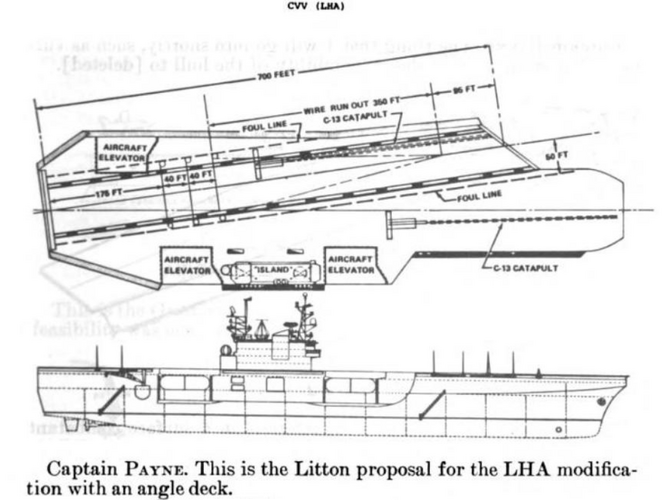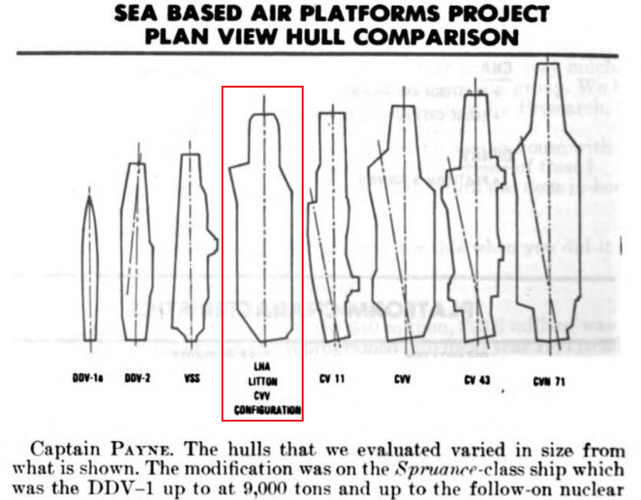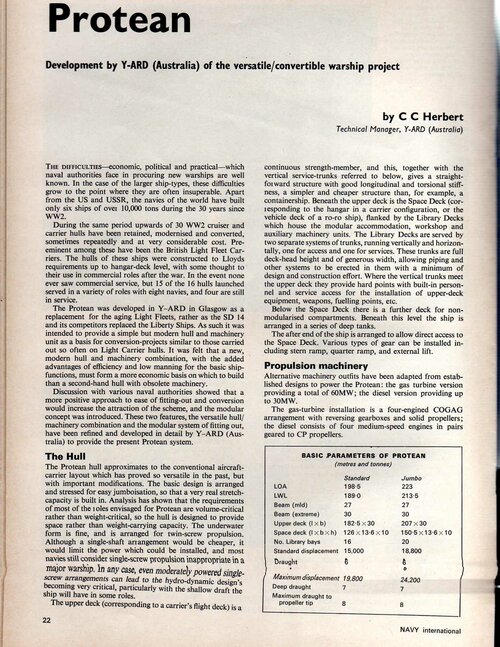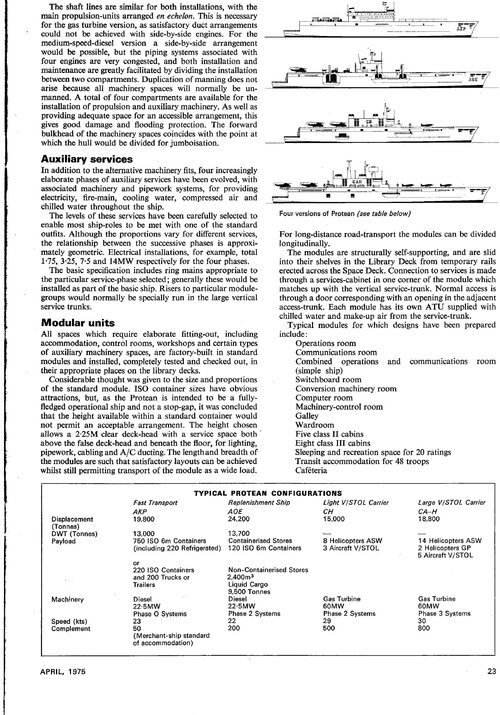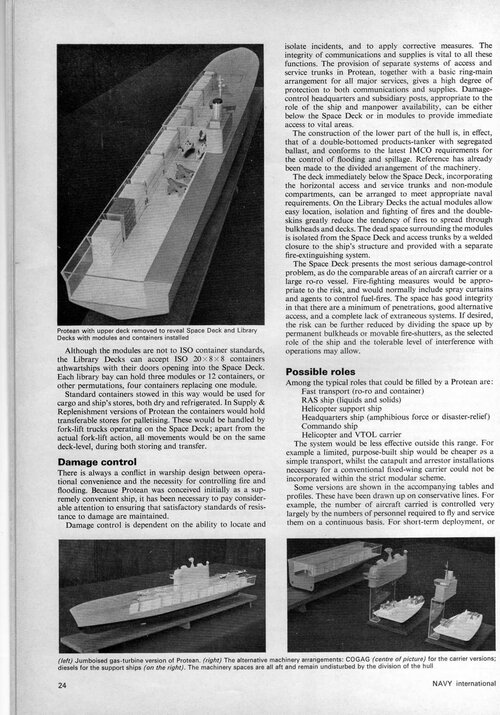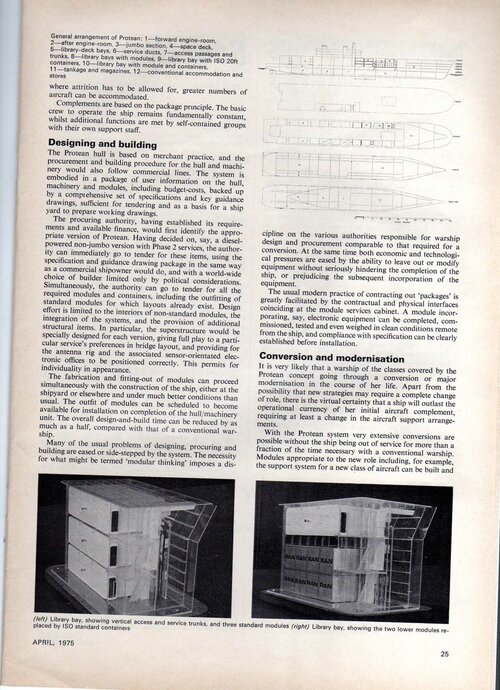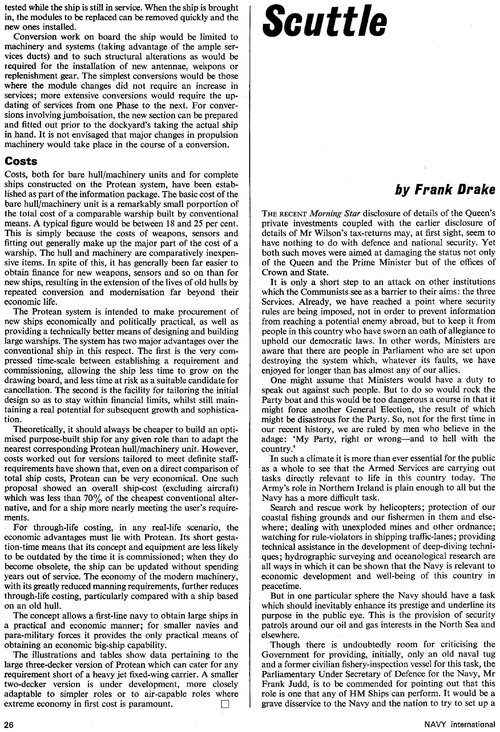You are using an out of date browser. It may not display this or other websites correctly.
You should upgrade or use an alternative browser.
You should upgrade or use an alternative browser.
Zumwalt "borrows" (and adapts) European carrier designs...
NOMISYRRUC
ACCESS: Top Secret
- Joined
- 28 September 2008
- Messages
- 2,327
- Reaction score
- 3,734
I think you're comparing apples and pears. Crotale was a point defence SAM and MASURCA was an area defence SAM.Compared to the Crotales of the 80's, the MASURCA was a massive system, to the point the Suffrens were designed around the huge thing. Up to 450 tons, according to Wikipedia.
If fitting area defence SAMs to aircraft carriers was a bad idea the designers of PA58 were in good company. CVA.01 was to have had Sea Dart while Kitty Hawk, Constellation and America were completed with a pair of Terrier launchers and Enterprise was fitted for-but-not-with a pair of Terrier launchers. Admittedly the USN replaced them with Sea Sparrow later and as far as I know Sea Sparrow was the American equivalent of Crotale.
As far as I know not fitting Terrier to Enterprise was a cost cutting measure and because money would be less of an object "in this version of history" I'd expect the ship to be completed with Terrier which would be replaced by Standard SM-1 in a "get well" refit in the late 1960s/early 1970s. Then as part of her 1979-82 refit Standard SM-1 would give way to SM-2, the SPS32/33s would be replaced by SPY-1A radars and the Aegis combat system would be fitted.
NOMISYRRUC
ACCESS: Top Secret
- Joined
- 28 September 2008
- Messages
- 2,327
- Reaction score
- 3,734
In common with "le weekend" and "le hotdog".I think the English word remains unchanged.
NOMISYRRUC
ACCESS: Top Secret
- Joined
- 28 September 2008
- Messages
- 2,327
- Reaction score
- 3,734
So it was effectively a successor to the SCB.100. In which case the projected air group for the CVV was peculiar. From Post 30...That wasn't the role of the CVV. It was to do the fleet escort and sea control role freeing the big carriers for strike. That's why they dropped the attack aircraft and kept the fighters and all the support aircraft in the wing. Would Congress have used it to attack the CVNs? Yes. Would I have rather had more Kennedys? Yes. But the stated purpose was to free up the CVAs from doing things like escorting REFORGER so they could focus on attack missions against the Soviets and WP in event of war.For comparison the early 1980s air group of a Midway was 70 aircraft (24 F-4J, 24 A-7E, 10 A-6E, 4 KA-6D, 4 EA-6B and 4 E-2C) and the "Supers" had air groups of 86 aircraft (24 F-14A or F-4J, 24 A-7E, 10 A-6E, 4 KA-6D, 4 EA-6B. 4 E-2C, 10 S-3A and 6 SH-3H).
Focusing on the attack carrier mission, I’ve been idly wondering if a smaller carrier than CVV might have worked.
CVV was in some ways too big - too close in size to a CVN, but sacrificed too much capability so was never going to compare well to a Nimitz. But perhaps if one could build an attack carrier half the size of a CVN at half the cost, things would be different?
To test this out, I’m playing around with my 45,000 ton medium carrier. Half the propulsion of a CVN, no expensive nuke plant, half the catapults, half the elevators, half the manpower…
Looks like it could take approx. 52 aircraft: 30 F/A-18, 10 A-6E, 4 KA-6D, 4 EA-6B and 4 E-2C.
I’ll have to draw it up.
Of course might be tough to build for half of what a CVN cost…
CVV: 50 aircraft - 10 F-14A, 12 A-6D/E, 2 KA-6D, 4 EA-6B, 4 E-2C, 10 S-3A and 8 LAMPS III.
SCB.100: 47 aircraft - 20 S-2, 16 SH-3, 2 UH-2, 1 C-2, 4 E-2 and 4 A-4 in its SCB.100.68 and SCB.100.71 forms.
Except 20 S-2 is probably a typo on my part for 20 S-3 and 4 A-4 is probably a typo on my part for 4 F-4. I'll check my copy of Friedman's U.S. Aircraft Carriers when I get home. [Edit. It was 20 S-2 and 4 A-4 after all.)
As I understand it the plan at circa 1965 was:
- That the CVS force (which had been made redundant in the mid-ocean ASW role by the P-3) was to be reduced from 9 ships to 6 ships. The survivors would escort the attack carriers, which had become more vulnerable to attack by Soviet submarines.
- The USN was using the "rule of three" so 15 attack carriers were needed so that 5 would be forward deployed at all times (3 in the Western Pacific and 2 in the Mediterranean) and 6 CVS were needed so that 2 would be forward deployed at all times (one in the Western Pacific and one in the Mediterranean).
- The SCB.27A Essex class that currently formed the CVS force would be replaced by SCB.27C ships as the latter were replaced in the CVA role by new construction.
- The SCB.27C Essex class would in turn be replaced by the SCB.100 class.
- 187 S-3A Vikings were built because that was the number required to support a front-line of 120 aircraft in 12 squadrons of 10 aircraft. That is 20 per CVS.
Returning to the CVV I can understand why it would have 10 Tomcats because they would contribute to the defence of the "supers" in the fleet escort role and act as "anti-shadowers" in REFORGER, but the 12 A-6D/Es and 4 EA-6Bs don't look right.
Last edited:
NOMISYRRUC
ACCESS: Top Secret
- Joined
- 28 September 2008
- Messages
- 2,327
- Reaction score
- 3,734
USN Part 4 - Some of which repeats what I've already written.Phase 1 manages to get 72 decks & carriers in three categories - small, medium, and large
10 000 to 25 000 tons
> 25000 to 45 000 tons
> above 50 000 tons.
The small ones receive N-156N for limited air defense.
The medium ones have Crusader, Skylancer, and Super Tiger
The heaviest have Crusader III and Phantom.
This would be the swansong of the WWII built escort carriers. As I wrote earlier in the thread the USN still had 66 of them in 1956 and wouldn't start discarding them until 1959.
The 66 escort carriers comprised 10 Bogues, 34 Cassablancas, 19 Commencement Bays and 3 Sangamons.
- 30 ships were reclassified "Escort Helicopter Aircraft Carriers" (CVHE) on 12th June 1955. That is all 10 Bogues, 10 Cassablancas, 7 Commencement Bays and all 3 Sangamons.
- 23 ships were reclassified "Utility Aircraft Carriers" (CVU) on 12th June 1955. They were all Cassablancas.
- The 34th Cassablanca was Thetis Bay. She was reclassified "Assault Helicopter Aircraft Carrier-One" (CVHE-1) on 1st July 1955.
- 12 Commencement Bays retained the "Escort Aircraft Carrier" (CVE) classification.
- 7 were decommissioned 1946-47 or went straight into reserve. These were the ships that received the CVHE designation in 1955.
- 9 remained in commission.
- 3 were decommissioned in 1946 but were re-commissioned in 1951 which increased the total in commission to 12.
- They decommissioned between February 1954 and August 1957 with 3 still being in service in the middle of 1956.
- According to Friedman 10 were modernised. I've not checked, but it's likely that they were 10 of the 12 ships that were active in the 1950s.
I'd also expect the USN to buy hundreds of HSS Seabat helicopters to operate from them. Except that according to my Putnams on US Navy aircraft the USN bought 350 in the "real world" and more were built under the Mutual Aid Program. According to that book the Seabat could carry a dipping sonar or homing torpedoes so it's likely that development of the Sea King would be "wanked" to get an aircraft that could carry a dipping sonar and homing torpedoes into service sooner. That or produce an ASW version of the HR2S or "make do" with the Bell HSL. I was going to suggest an ASW version of one of Vertol's twin-rotor helicopters but none of the machines that were available in 1956 looked suitable. Does anyone know better than me about that?
Earlier in the thread I also suggested that the USN would put the SCB.43 escort carrier into production. When I looked this up in Friedman I saw that the USN studied CVEs based on the Neosho class oiler and Mariner class cargo ship as alternatives.
NOMISYRRUC
ACCESS: Top Secret
- Joined
- 28 September 2008
- Messages
- 2,327
- Reaction score
- 3,734
Basically their AIP submarines start playing havoc with international maritime traffic, paralyzing it.
They also have limited SAM capability to screw air traffic over the Atlantic. Perhaps with evolved Me-163 or Bachem Natters launched from ramps and recovered... by parachutes.
In reverse.In phase 1, the USN, RN and their allies makes an all-out, huge effort to get as many carrier decks as feasible. Meanwhile any available battleship and cruiser is given heavy SAM (for air defense) and cruise missiles (Regulus).
Why cruise missiles? They're not exactly anti-submarine weapons.
The USN was in the process of learning that new guided missile ships were more cost effective than conversions.
Having written that in September 1956 the USN did produce a programme for 104 new missile ships and 12 cruiser conversions to be ordered from FY 1957 to FY 1962. The new ships were 3 CGN, 51 DLG & 50 DDG and the conversions were 4 CAG & 8 CLG. One GGN, 2 DLGN, 28 DLG & 23 DDG (total 54 ships) were actually built and 3 Bostons & 6 Clevelands were converted to guided missile cruisers.
As far as I know only half of the projected ships were built due to a combination of the following.
- Cost overruns.
- The first generation SAMs were chronically unreliable so Congress was reluctant to authorise ships armed with weapons that didn't work.
- The "crash programme" of Polaris submarines being given priority for the money that was available.
- The USN thought Typhon would render the 3-T missiles obsolete and it didn't want to saddle itself with a surfeit of ships armed with obsolete weapons.
Last edited:
- Joined
- 21 May 2006
- Messages
- 3,002
- Reaction score
- 2,268
Thank you BlackBat242 for your time and effort.Yes, we do.
PA-59
According to the 2006 excellent monograph on the Clémenceau and Foch by Jean Moulin (a MUST on all Marine Nationale carriers from PA-01 to Charles de Gaulle) :
PA-59 would have shared the same hull and machinery as PA-54 with an all-missile armament involving US Terriers.
Conway's Fighting Ships 1947-1995 has only (in the entry for PA58):
Quote:
PA58, possibly to have been named Verdun, was delayed by financial problems, and the Defence Staff considered a smaller design, derived from Clemenceau, in which the after guns would have been replaced by Masurcas, before the project was finally abandoned in 1961.
http://www.stratisc.org/PA8.htm
[Hervé Coutau-Bégarie]
Le troisième de la série, provisoirement dénommé PA 58 (le nom de Verdun a été proposé) et destiné à remplacer l’Arromanches dont le désarmement est prévu en 1962, doit être inscrit au budget de 1958, mais il est supprimé à la dernière minute pour raisons budgétaires, si bien que la tranche de 1958 se retrouve pratiquement réduite à rien. La Marine essaie de relancer l’affaire l’année suivante avec le PA 59, qui devrait être un Clemenceau amélioré ou un porte-avions plus grand, de 35 000 tonnes, capable de mettre en œuvre des avions de bombardement stratégique constituant « la puissance de frappe "résiduelle" de la France » [4]. Le Conseil Supérieur de la Marine en délibère dans sa séance des 5/6 mai 1958. M. Alain Poher (dernier secrétaire d’état à la Marine) impose la solution du Clemenceau pour des raisons budgétaires (35 milliards au lieu de 45 à 47 pour le 35 000 tonnes). Mais la priorité donnée par la Ve République à la force de frappe enterre définitivement le projet. La Marine conserve pendant quelques temps encore l’espoir de le faire reprendre : elle envisage, dans le cadre de la loi de programme 1960-64, une mise sur cale en 1962, avec admission au service actif en 1967 [5]. Ce beau projet ne sera pas réalisé
Note that Masurca was a French-designed SAM, designed from 1955 on, which entered service in 1966 - the Mk 2 version, which incorporated technology from Terrier and Tartar (with USN co-operation) began production the same year, and quickly replaced the Mk1s..
Also note that I do NOT have the Jean Moulin work... I got that from another website.
The only drawing I have is this... it shows the missile launchers replacing the forward 100mm gun set on the starboard side. This matches with the historic replacement of the aft port and fore starboard 100mm gun sets in the mid-1980s with 2 × SACP Crotale EDIR systems, with 52 missiles.
View attachment 685272View attachment 685274View attachment 685275
Note that removing the aft starboard 100mm gun set could allow a flight deck extension providing parking for 3-4 more aircraft aft of the deck-edge lift without impacting landing operations.
Regards
Pioneer
Let's say I threw a half-baked idea at a wall in the hope something stuck... and you are throwing a lot of things - a lot of which are very interesting. I'm fine with that - the thread OP being merely a pretext to learn a lot of stuff about aircraft carriers...
Fun thing about Terrier/SM-1 launchers; they could fire ASROC.I think you're comparing apples and pears. Crotale was a point defence SAM and MASURCA was an area defence SAM.Compared to the Crotales of the 80's, the MASURCA was a massive system, to the point the Suffrens were designed around the huge thing. Up to 450 tons, according to Wikipedia.
If fitting area defence SAMs to aircraft carriers was a bad idea the designers of PA58 were in good company. CVA.01 was to have had Sea Dart while Kitty Hawk, Constellation and America were completed with a pair of Terrier launchers and Enterprise was fitted for-but-not-with a pair of Terrier launchers. Admittedly the USN replaced them with Sea Sparrow later and as far as I know Sea Sparrow was the American equivalent of Crotale.
As far as I know not fitting Terrier to Enterprise was a cost cutting measure and because money would be less of an object "in this version of history" I'd expect the ship to be completed with Terrier which would be replaced by Standard SM-1 in a "get well" refit in the late 1960s/early 1970s. Then as part of her 1979-82 refit Standard SM-1 would give way to SM-2, the SPS32/33s would be replaced by SPY-1A radars and the Aegis combat system would be fitted.
NOMISYRRUC
ACCESS: Top Secret
- Joined
- 28 September 2008
- Messages
- 2,327
- Reaction score
- 3,734
For what it's worth I knew.Fun thing about Terrier/SM-1 launchers; they could fire ASROC.I think you're comparing apples and pears. Crotale was a point defence SAM and MASURCA was an area defence SAM.Compared to the Crotales of the 80's, the MASURCA was a massive system, to the point the Suffrens were designed around the huge thing. Up to 450 tons, according to Wikipedia.
If fitting area defence SAMs to aircraft carriers was a bad idea the designers of PA58 were in good company. CVA.01 was to have had Sea Dart while Kitty Hawk, Constellation and America were completed with a pair of Terrier launchers and Enterprise was fitted for-but-not-with a pair of Terrier launchers. Admittedly the USN replaced them with Sea Sparrow later and as far as I know Sea Sparrow was the American equivalent of Crotale.
As far as I know not fitting Terrier to Enterprise was a cost cutting measure and because money would be less of an object "in this version of history" I'd expect the ship to be completed with Terrier which would be replaced by Standard SM-1 in a "get well" refit in the late 1960s/early 1970s. Then as part of her 1979-82 refit Standard SM-1 would give way to SM-2, the SPS32/33s would be replaced by SPY-1A radars and the Aegis combat system would be fitted.
However, your reminder has made me think that because this is as much an "ASW wank" as much as it is a "carrier wank" the magazines of the Mk 10 GMLSs would be packed with ASROCs instead of Terriers.
Because I don't want to create a new thread... how about merging a) PA.58 b) Medium Fleet Carrier, 1956 and c) CVS, SCB.100 - into a NATO carrier; to replace all those Colossus, Majestic and the few Independances, here and there ?
Last edited:
- Joined
- 27 September 2006
- Messages
- 6,413
- Reaction score
- 6,794
This is an interesting thread for trying out the numerous small to large carrier designs postwar.
Some things cannot be changed unless you want a fantasy rather than practical fleet.
VSTOL. As the F35B continues to show, VSTOL aircraft are more expensive and less capable than a comparable conventional design.
The Harrier in its various versions only found a home with navies who could not operate carriers with catapults. F35B has found a similar customer base.
In NATO that has been Italy, Spain , UK and US Marines.
Each of these users also had very different ideas about the ships needed to operate fixed wing jets. Italy(Garibaldi, Cavour) Spain (Asturias, Juan Carlos) UK (Invincible, QE) and US (Iwo Jima, Tarawa, Wasp, America)
So no basis for a common type of ship.
ASW. Shipborne ASW evolved into fixed and rotary forces. However, by 1980 only the USN continued to.operate fixed wing ASW with the S3. Now all NATO navies rely on rotary ASW.
The S3 Sea King had established itself by 1980 as the main ASW helo. But France and Italy prefered their own designs. Canada and the Netherlands got rid of ASW carriers in the late 60s in favour of escort ships.
All navies have now dispersed their ASW helos on escort ships. Italy, Spain, UK and US have retained carrier borne ASW helos but only on ships also operating fast jets.
All in all hard to see how you change this evolution.
Some things cannot be changed unless you want a fantasy rather than practical fleet.
VSTOL. As the F35B continues to show, VSTOL aircraft are more expensive and less capable than a comparable conventional design.
The Harrier in its various versions only found a home with navies who could not operate carriers with catapults. F35B has found a similar customer base.
In NATO that has been Italy, Spain , UK and US Marines.
Each of these users also had very different ideas about the ships needed to operate fixed wing jets. Italy(Garibaldi, Cavour) Spain (Asturias, Juan Carlos) UK (Invincible, QE) and US (Iwo Jima, Tarawa, Wasp, America)
So no basis for a common type of ship.
ASW. Shipborne ASW evolved into fixed and rotary forces. However, by 1980 only the USN continued to.operate fixed wing ASW with the S3. Now all NATO navies rely on rotary ASW.
The S3 Sea King had established itself by 1980 as the main ASW helo. But France and Italy prefered their own designs. Canada and the Netherlands got rid of ASW carriers in the late 60s in favour of escort ships.
All navies have now dispersed their ASW helos on escort ships. Italy, Spain, UK and US have retained carrier borne ASW helos but only on ships also operating fast jets.
All in all hard to see how you change this evolution.
Agree… would need some kind of modular design, ranging from 20,000 to 40,000 tons, 25-30 knots, steam or COSAG plant, designed for ease of production and maintenance.All in all hard to see how you change this evolution
With combat systems and weapons being chosen by each country.
On the aviation side would also probably require earlier development of ski jump and STOBAR concepts and (most of all) a cheap supersonic fighter with look down shoot down capability at least a decade before the F/A-18 was available (something like the F-8 Twosader with Spey engine and simplified A-7 wing).
Tall order…
Scott Kenny
ACCESS: USAP
- Joined
- 15 May 2023
- Messages
- 11,513
- Reaction score
- 14,082
Why H-56 Cheyennes? Little of the Naval LAMPS mission requires speed, but it does need lots of hovering. I mean, I love the Cheyenne as an Army (or Marine) helicopter. I'm just not sold on it as a Navy helo.Running with the idea,
Invincible had an air wing of 22, which is a few less than a WW2 CVE. Either 4 Sea Kings and 18 Harriers or 10 Sea Kings and 12 Harriers. For simplicity I'm going to go with 22 and not worry about spotting factors. I'd say the ship wing would be 4 - let's call them MH-56 - ASW/SAR/SUW helicopters, and 4-6 (I'm leaning to 6) EV-84 AEW, just to ensure an EV-84 could be on station all the time. That leaves around 12 aircraft that can vary by mission.
Yeah, aluminum is for airplanes, steel is for ships!I wonder if the 120 x 85 is the minimum or if something like 118 x 78-80 could also get you both? I once thought I was so clever figuring out it must be a top weight issue and that simply using aluminum to lower the weight would be the solution...yeah right up until the point I realized a decent jet fuel fire would burn hot enough to melt the aluminum in the gallery deck and make a real mess of things. lol
Only 4x A-4s seems odd to me. That means the SCB100 isn't capable of maintaining a constant CAP to chase the Bears away. According to the UK RN, you need a minimum of 8x whatever type to keep 2x birds up 24/7. I'd expect a change to ~16x S-2 to make space for 8x A-4s (ignoring spot factors).So it was effectively a successor to the SCB.100. In which case the projected air group for the CVV was peculiar. From Post 30...
CVV: 50 aircraft - 10 F-14A, 12 A-6D/E, 2 KA-6D, 4 EA-6B, 4 E-2C, 10 S-3A and 8 LAMPS III.SCB.100: 47 aircraft - 20 S-2, 16 SH-3, 2 UH-2, 1 C-2, 4 E-2 and 4 A-4 in its SCB.100.68 and SCB.100.71 forms.
Except 20 S-2 is probably a typo on my part for 20 S-3 and 4 A-4 is probably a typo on my part for 4 F-4. I'll check my copy of Friedman's U.S. Aircraft Carriers when I get home. [Edit. It was 20 S-2 and 4 A-4 after all.)
Agreed, that seems very odd. You only need Intruders and Prowlers for strike missions, and I don't believe that Strike missions were in the CVV docket.Returning to the CVV I can understand why it would have 10 Tomcats because they would contribute to the defence of the "supers"in the fleet escort role and act as "anti-shadowers" in REFORGER, but the 12 A-6D/Es and 4 EA-6Bs don't look right.
OK according to @Bill S an A-7E two-seater with afterburning TF41 was proposed (using the F-4K’s afterburner section no less!).On the aviation side would also probably require earlier development of ski jump and STOBAR concepts and (most of all) a cheap supersonic fighter with look down shoot down capability at least a decade before the F/A-18 was available (something like the F-8 Twosader with Spey engine and simplified A-7 wing
… so pretty much the perfect starting point for a cheap supersonic fighter circa late 60s. Add a mini ski jump + catapult and you’re in business!
Post in thread 'Vought (LTV) A-7 Corsair II Projects'
https://www.secretprojects.co.uk/threads/vought-ltv-a-7-corsair-ii-projects.11/post-78886
- Joined
- 27 September 2006
- Messages
- 6,413
- Reaction score
- 6,794
The US Navy pretty much has to go with the Nimitz class in the 1970s onwards. Any additional resources for carriers would only make sense if it added more Nimitz.
A restricted Defence Budget post 1975 and going forward into the 1980s might have happened if the Soviet Union had not been deploying new naval assets like Kiev class and Backfire. Had Breshnev left the stage sooner a successor (still Andropov?) might have opted to ease the burden of military expenditure to improve life for Russians.
Pressure to build something cheaper than the Nimitz class may just have resulted in fewer Nimitz spread over more years. The arguments against smaller, less capable ships would lose none of their strength.
As for the other potential carrier nations.
France The Clemenceau and Foch are hard to replace. The evolution from the PH75 Jean D'Arc replacement to the nuclear De Gaulle carrier suggests that a national design and build had no alternative.
Italy Italy evolved its ASW helicopter ships from cruisers to the light Garibaldi carrier. Its size and armament reflect Italian concerns in the Mediterranean. Italian industry has only one big ship order and makes the most of it.
Spain The Spanish are very pragmatic. Only the US will supply the Franco regime with warships. The replacement for Dedalo is initially named for an assassinated Admiral- Carrero Blanco.
UK As readers of this site will know, the RN fills the gap left by cancelling its fixed wing carriers in 1966 by going back to the Escort Cruiser design dropped in 1962. Six ships were originally planned. Getting three in the dire circumstances of 70s Britain nearly failed and the Nott Review reduced them to two before the Falklands War rescued them.
I really cant see a multinational carrier programme being chosen instead.
USA The US Navy builds the Tarawa class LHAs alongside the Nimitz. Having trialed Iwo Jima as an interim Sea Control Ship US Marine Harriers come aboard the Tarawas.
The answer to getting more ASW air to sea takes the form of new SH60s on Spruance and then Perry escorts. These use up the shipbuilding capacity and squeeze out the Sea Control Ship.
Sometimes real world weapons evolution is hard to get around.
A restricted Defence Budget post 1975 and going forward into the 1980s might have happened if the Soviet Union had not been deploying new naval assets like Kiev class and Backfire. Had Breshnev left the stage sooner a successor (still Andropov?) might have opted to ease the burden of military expenditure to improve life for Russians.
Pressure to build something cheaper than the Nimitz class may just have resulted in fewer Nimitz spread over more years. The arguments against smaller, less capable ships would lose none of their strength.
As for the other potential carrier nations.
France The Clemenceau and Foch are hard to replace. The evolution from the PH75 Jean D'Arc replacement to the nuclear De Gaulle carrier suggests that a national design and build had no alternative.
Italy Italy evolved its ASW helicopter ships from cruisers to the light Garibaldi carrier. Its size and armament reflect Italian concerns in the Mediterranean. Italian industry has only one big ship order and makes the most of it.
Spain The Spanish are very pragmatic. Only the US will supply the Franco regime with warships. The replacement for Dedalo is initially named for an assassinated Admiral- Carrero Blanco.
UK As readers of this site will know, the RN fills the gap left by cancelling its fixed wing carriers in 1966 by going back to the Escort Cruiser design dropped in 1962. Six ships were originally planned. Getting three in the dire circumstances of 70s Britain nearly failed and the Nott Review reduced them to two before the Falklands War rescued them.
I really cant see a multinational carrier programme being chosen instead.
USA The US Navy builds the Tarawa class LHAs alongside the Nimitz. Having trialed Iwo Jima as an interim Sea Control Ship US Marine Harriers come aboard the Tarawas.
The answer to getting more ASW air to sea takes the form of new SH60s on Spruance and then Perry escorts. These use up the shipbuilding capacity and squeeze out the Sea Control Ship.
Sometimes real world weapons evolution is hard to get around.
- Joined
- 27 September 2006
- Messages
- 6,413
- Reaction score
- 6,794
Given the threat to the North Atlantic posed by the Soviet missiles launched from Backfires, surface ships and submarines it is hard to see a substitute for the Nimitz with its mix of F14, A7, A6 and S3 aircraft.
None of the aircraft proposed for smaller carriers can match this combination. But after the Cold War ended the F/A 18 and SH60 are able to replace them. Coral Sea and Midway gained a new lease of life frpm the Hornet.
In a lower threat environment the range and loading of the Nimitz even with a Hornet airgroup has still clinched its place over smaller conventionally powered alternatives.
None of the aircraft proposed for smaller carriers can match this combination. But after the Cold War ended the F/A 18 and SH60 are able to replace them. Coral Sea and Midway gained a new lease of life frpm the Hornet.
In a lower threat environment the range and loading of the Nimitz even with a Hornet airgroup has still clinched its place over smaller conventionally powered alternatives.
- Joined
- 15 July 2007
- Messages
- 4,880
- Reaction score
- 4,531
It's probably a none starter without other changes and some kind of tripartite compromise.Because I don't want to create a new thread... how about merging a) PA.58 b) Medium Fleet Carrier, 1956 and c) CVS, SBC.100 - into a NATO carrier; to replace all those Colossus, Majestic and the few Independances, here and there ?
Starting with the limitations of drydocks and other facilities.
That said USN plant, shafts and props from the Forrestal allows a twin shaft CV of reasonable capability. A lot more capability and lower through-life costs than a revamped Essex.
Scott Kenny
ACCESS: USAP
- Joined
- 15 May 2023
- Messages
- 11,513
- Reaction score
- 14,082
You still need convoy escorts, and nobody wants to use a Nimitz for that if it's at all possible.Given the threat to the North Atlantic posed by the Soviet missiles launched from Backfires, surface ships and submarines it is hard to see a substitute for the Nimitz with its mix of F14, A7, A6 and S3 aircraft.
None of the aircraft proposed for smaller carriers can match this combination. But after the Cold War ended the F/A 18 and SH60 are able to replace them. Coral Sea and Midway gained a new lease of life frpm the Hornet.
In a lower threat environment the range and loading of the Nimitz even with a Hornet airgroup has still clinched its place over smaller conventionally powered alternatives.
So a smaller carrier makes sense. The obvious one here would be the Midways. The LHA-sized baby carriers are stuck with using A4s as their fighters for CAP.
- Joined
- 27 September 2006
- Messages
- 6,413
- Reaction score
- 6,794
I think convoys by the 1980s had changed from the 1950s when NATO had a few S2 capable carriers.
The arrival of faster Ro Ro and Container ships made it easier for dashes like those done by Queen Mary in WW2.
The emphasis on route clearing by USN Spruances and Knoxes and RN T22 and T12 had taken over.
The RN Invincibles were assigned to clear the way for the US Striking Fleet or escort the Royal Marines to Norway.
The Coral Sea (Midway in the Pacific) was usually paired with a Nimitz/Forrestal.
I dont think NATO had a requirement for CVS ships for convoy duties.
The arrival of faster Ro Ro and Container ships made it easier for dashes like those done by Queen Mary in WW2.
The emphasis on route clearing by USN Spruances and Knoxes and RN T22 and T12 had taken over.
The RN Invincibles were assigned to clear the way for the US Striking Fleet or escort the Royal Marines to Norway.
The Coral Sea (Midway in the Pacific) was usually paired with a Nimitz/Forrestal.
I dont think NATO had a requirement for CVS ships for convoy duties.
NOMISYRRUC
ACCESS: Top Secret
- Joined
- 28 September 2008
- Messages
- 2,327
- Reaction score
- 3,734
For what it's worth (1) the Essex class ASW carriers only carried 4 or 5 A-4s to "chase the Bears away" as well.Only 4x A-4s seems odd to me. That means the SCB100 isn't capable of maintaining a constant CAP to chase the Bears away. According to the UK RN, you need a minimum of 8x whatever type to keep 2x birds up 24/7. I'd expect a change to ~16x S-2 to make space for 8x A-4s (ignoring spot factors).So it was effectively a successor to the SCB.100. In which case the projected air group for the CVV was peculiar. From Post 30...
CVV: 50 aircraft - 10 F-14A, 12 A-6D/E, 2 KA-6D, 4 EA-6B, 4 E-2C, 10 S-3A and 8 LAMPS III.SCB.100: 47 aircraft - 20 S-2, 16 SH-3, 2 UH-2, 1 C-2, 4 E-2 and 4 A-4 in its SCB.100.68 and SCB.100.71 forms.
Except 20 S-2 is probably a typo on my part for 20 S-3 and 4 A-4 is probably a typo on my part for 4 F-4. I'll check my copy of Friedman's U.S. Aircraft Carriers when I get home. [Edit. It was 20 S-2 and 4 A-4 after all.]
See the following examples from the gonanavy.jp website.
CVSG-56 on Yorktown from September to December 1969 with 4 A-4Cs

CVSG-56 on Intrepid from July to October 1972 with 5 A-4E

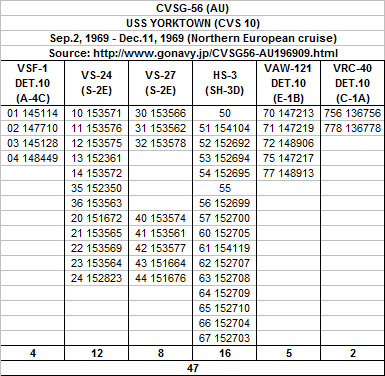
CVSG-56 on Intrepid from July to October 1972 with 5 A-4E
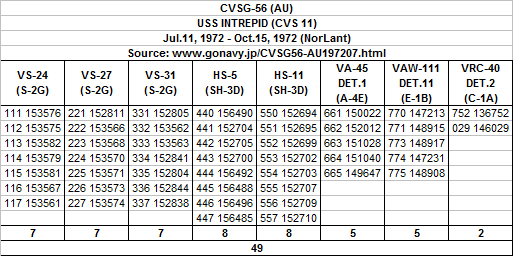
For what it's worth (2) those air groups are rather similar to the proposed air group for SCB.100.
- 1969 - 47 aircraft: 20 S-2, 16 SH-3, 5 E-1, 2 C-1 and 4 A-4.
- 1972 - 49 aircraft: 21 S-2, 16 SH-3, 5 E-1, 2 C-1 and 5 A-4.
SSgtC
ACCESS: Top Secret
- Joined
- 13 July 2020
- Messages
- 1,240
- Reaction score
- 2,884
Personally, I've always gotten the impression that the A-4 was used as the primary CVSG "fighter" because it was the only type in general naval service that could be reliably launched from the H-8 cats of the -27A ships. And then institutional inertia kept it there (well, that and a lack of more suitable fighter types due to losses over Vietnam and budget cuts to procurement programs, again due to Vietnam).For what it's worth (1) the Essex class ASW carriers only carried 4 or 5 A-4s to "chase the Bears away" as well.
See the following examples from the gonanavy.jp website.
CVSG-56 on Yorktown from September to December 1969 with 4 A-4Cs
View attachment 709755
CVSG-56 on Intrepid from July to October 1972 with 5 A-4E
View attachment 709757
For what it's worth (2) those air groups are rather similar to the proposed air group for SCB.100.
- 1969 - 47 aircraft: 20 S-2, 16 SH-3, 5 E-1, 2 C-1 and 4 A-4.
- 1972 - 49 aircraft: 21 S-2, 16 SH-3, 5 E-1, 2 C-1 and 5 A-4.
Scott Kenny
ACCESS: USAP
- Joined
- 15 May 2023
- Messages
- 11,513
- Reaction score
- 14,082
That may have been the plan for all the types, but that's still inadequate to keep a CAP up 24/7.For what it's worth (1) the Essex class ASW carriers only carried 4 or 5 A-4s to "chase the Bears away" as well.
See the following examples from the gonanavy.jp website.
CVSG-56 on Yorktown from September to December 1969 with 4 A-4Cs
View attachment 709755
CVSG-56 on Intrepid from July to October 1972 with 5 A-4E
View attachment 709757
For what it's worth (2) those air groups are rather similar to the proposed air group for SCB.100.
- 1969 - 47 aircraft: 20 S-2, 16 SH-3, 5 E-1, 2 C-1 and 4 A-4.
- 1972 - 49 aircraft: 21 S-2, 16 SH-3, 5 E-1, 2 C-1 and 5 A-4.
And while A-4s are capable dogfighters (see their use as Aggressors even today), they're not fast enough to launch and get up to a snooping Bear before the carrier group and/or convoy are found. They need to be in the air already to be able to chase the snooping Bear away.
A Tentative Fleet Plan
I really should change my personal text
- Joined
- 9 April 2018
- Messages
- 1,211
- Reaction score
- 2,821
The Scheme 62 CVS designs were supposed to carry 20 Phantoms.
The Scheme 62 CVS designs were supposed to carry 20 Phantoms.
Interesting. Is that in addition to the 20 S-2s and 4 E-1s (and 16 SH-3s?) mentioned in Friedman’s comparison table?
- Joined
- 16 April 2008
- Messages
- 9,597
- Reaction score
- 14,456
Interesting. Is that in addition to the 20 S-2s and 4 E-1s (and 16 SH-3s?) mentioned in Friedman’s comparison table?

Friedman walks though quite a few variations of airwing in these 1960-62 carriers but he's not entirely clear on which one goes with which entry in the table.
1) The initial June 1959 design had 50 aircraft: 8 fighters (either Missileer or Phantom) plus 20 S-2, 16 Sea King, 4 E-2A, and 2 Seasprites.
2) The April 1960 design shown in the table eliminated Phantom as an option, as shown by the use of the short C-11 cats.
3) By December 1960, Missileer was dead and the airwing needed 24 Phantoms (and Terrier) in lieu of 8 Missileers. But it's not clear whether the Scheme 62 studies are based on this airwing or not. If they are, the rest of the airwing would be much smaller and less capable of ASW. He does note that these were essentially minimum Phantom carriers, and not exactly pure ASW ones (they had much bigger magazines than needed for ASW, for example). So it might be that they could carry 24 Phantom as attack carriers and only 8 as ASW ships, but Friedman doesn't say that,
Last edited:
- Joined
- 16 April 2008
- Messages
- 9,597
- Reaction score
- 14,456
The Tarawa class LHA is pretty close to being a CVS. If it had been in the Royal Navy it would have used both ASW and Commando Seakings.
Did Litton or anyone else offer a carrier version?
Yes, apparently, for the RAN. Thing is, it would not handle fixed-wing ASW/AEW aircraft or fighters without a massive redesign. And was probably too slow.
Post in thread 'New USN CVL' https://www.secretprojects.co.uk/threads/new-usn-cvl.36147/post-453164
SSgtC
ACCESS: Top Secret
- Joined
- 13 July 2020
- Messages
- 1,240
- Reaction score
- 2,884
This gets tossed around pretty regularly. The Tarawa class was almost uniquely unsuited for conversion to a carrier. They were small, slow, had extremely limited hanger, ordinance and fuel storage space. To convert them into real, full time carriers would require a keel to masthead redesign. And by the time you do that, it's cheaper to just design an actual carrier instead of trying to shoehorn one into the Tarawa class hull.The Tarawa class LHA is pretty close to being a CVS. If it had been in the Royal Navy it would have used both ASW and Commando Seakings.
Did Litton or anyone else offer a carrier version?
Pirate Pete
ACCESS: Secret
- Joined
- 25 July 2007
- Messages
- 350
- Reaction score
- 582
I appreciate, going off at something of a tangent but there was this back in the late 1970’s:Agree… would need some kind of modular design, ranging from 20,000 to 40,000 tons, 25-30 knots, steam or COSAG plant, designed for ease of production and maintenance.
With combat systems and weapons being chosen by each country.
On the aviation side would also probably require earlier development of ski jump and STOBAR concepts and (most of all) a cheap supersonic fighter with look down shoot down capability at least a decade before the F/A-18 was available (something like the F-8 Twosader with Spey engine and simplified A-7 wing).
Tall order…
Attachments
Scott Kenny
ACCESS: USAP
- Joined
- 15 May 2023
- Messages
- 11,513
- Reaction score
- 14,082
That looks like a pretty reasonable escort carrier design. Significantly more flight deck area than the old Essex class, almost as much as a Midway. Only two catapults, but the bow cat is completely clear of the angled deck so you can simultaneously launch and recover. Looks like a good 45ktons, though.
Other interesting note is that both the DDV2 and the VSS designs appear to be using reverse angled decks. I hadn't expected that!
- Joined
- 16 April 2008
- Messages
- 9,597
- Reaction score
- 14,456
Here's the rest of that testimony, BTW.

The LHA CVV was dismissed for insufficent volume and stability.
There are some rather frustrating redactions in places, but it's a start. When I get a chance, I'll repost this in the SCS/VSS threads as well.
Hearings on Military Posture and H.R. 10929
www.google.com
The LHA CVV was dismissed for insufficent volume and stability.
There are some rather frustrating redactions in places, but it's a start. When I get a chance, I'll repost this in the SCS/VSS threads as well.
BlackBat242
OK, I changed my personal text ;)
- Joined
- 10 April 2013
- Messages
- 1,471
- Reaction score
- 4,240
There seems to be a page missing (26?) as the text on page 25 ends mid-sentence.I appreciate, going off at something of a tangent but there was this back in the late 1970’s:
Scott Kenny
ACCESS: USAP
- Joined
- 15 May 2023
- Messages
- 11,513
- Reaction score
- 14,082
Volume I'd kinda shrug at, it's going to be a convoy escort running a bunch of S2s or S3s and H3s, with some E2s and maybe 8x Skyhawks as CAP.Here's the rest of that testimony, BTW.

Hearings on Military Posture and H.R. 10929
www.google.com
The LHA CVV was dismissed for insufficent volume and stability.
There are some rather frustrating redactions in places, but it's a start. When I get a chance, I'll repost this in the SCS/VSS threads as well.
But lack of stability would be a killer for a carrier.
SSgtC
ACCESS: Top Secret
- Joined
- 13 July 2020
- Messages
- 1,240
- Reaction score
- 2,884
No. This was not a proposal for the Sea Control Ship. This was a proposal for the CVV. It was intended to be a medium attack carrier, not a replacement for the decommissioned anti-submarine carriers. Volume was much more critical for that design.Volume I'd kinda shrug at, it's going to be a convoy escort running a bunch of S2s or S3s and H3s, with some E2s and maybe 8x Skyhawks as CAP.
But lack of stability would be a killer for a carrier.
Scott Kenny
ACCESS: USAP
- Joined
- 15 May 2023
- Messages
- 11,513
- Reaction score
- 14,082
Ah, gotcha. Not sure why they wanted more Midways, then.No. This was not a proposal for the Sea Control Ship. This was a proposal for the CVV. It was intended to be a medium attack carrier, not a replacement for the decommissioned anti-submarine carriers. Volume was much more critical for that design.
SSgtC
ACCESS: Top Secret
- Joined
- 13 July 2020
- Messages
- 1,240
- Reaction score
- 2,884
They didn't. The testimony that was linked was provided to Congress giving them the options. One was refitting Coral Sea to make her roughly equal to Midway in size (hopefully with the stability problems resolved), another was refitting and recommisoning Intrepid, one was a new design CVV, and one was for basing the CVV on an LHA hull. And all of that was only done at Congressional and Presidential insistence. The Navy really only wanted more Nimitz class. They only showed the other options because they were forced too.Ah, gotcha. Not sure why they wanted more Midways, then.
Scott Kenny
ACCESS: USAP
- Joined
- 15 May 2023
- Messages
- 11,513
- Reaction score
- 14,082
"More Midways" as a shorthand for "more attack carriers the size of the Midways"They didn't. The testimony that was linked was provided to Congress giving them the options. One was refitting Coral Sea to make her roughly equal to Midway in size (hopefully with the stability problems resolved), another was refitting and recommisoning Intrepid, one was a new design CVV, and one was for basing the CVV on an LHA hull. And all of that was only done at Congressional and Presidential insistence. The Navy really only wanted more Nimitz class. They only showed the other options because they were forced too.
I can see the use for small carriers as convoy escorts, where an LHA CVV/CVS would make sense. I don't really see the point of attack carriers smaller than Nimitz class. Carriers are exponentially more effective the larger they get, since they basically all need the same size crew but a bigger hull gives you more aircraft for roughly the same operating costs.
- Joined
- 16 April 2008
- Messages
- 9,597
- Reaction score
- 14,456
"More Midways" as a shorthand for "more attack carriers the size of the Midways"
I can see the use for small carriers as convoy escorts, where an LHA CVV/CVS would make sense. I don't really see the point of attack carriers smaller than Nimitz class. Carriers are exponentially more effective the larger they get, since they basically all need the same size crew but a bigger hull gives you more aircraft for roughly the same operating costs.
Well, that was essentially where things ended up, but at the time, there was definitely a sense that the Nimitz class was exceptionally expensive and maybe something cheaper could do most of the job, considering that a sizable fraction of the job at the time looked to be showing up off someone's coastline with some strike aircraft and looking menacing.
In the end, overall cost was not that much less, mainly due to electronics and ancillaries. Especially once nuclear power was accepted as mandatory.
Similar threads
-
Eureka ! a naval Northrop N-156
- Started by Archibald
- Replies: 15
-
-
-
Tiger class cruisers opinions
- Started by uk 75
- Replies: 203
-
Warsaw Pact Britain - naval strategy and other considerations
- Started by Martes
- Replies: 371

